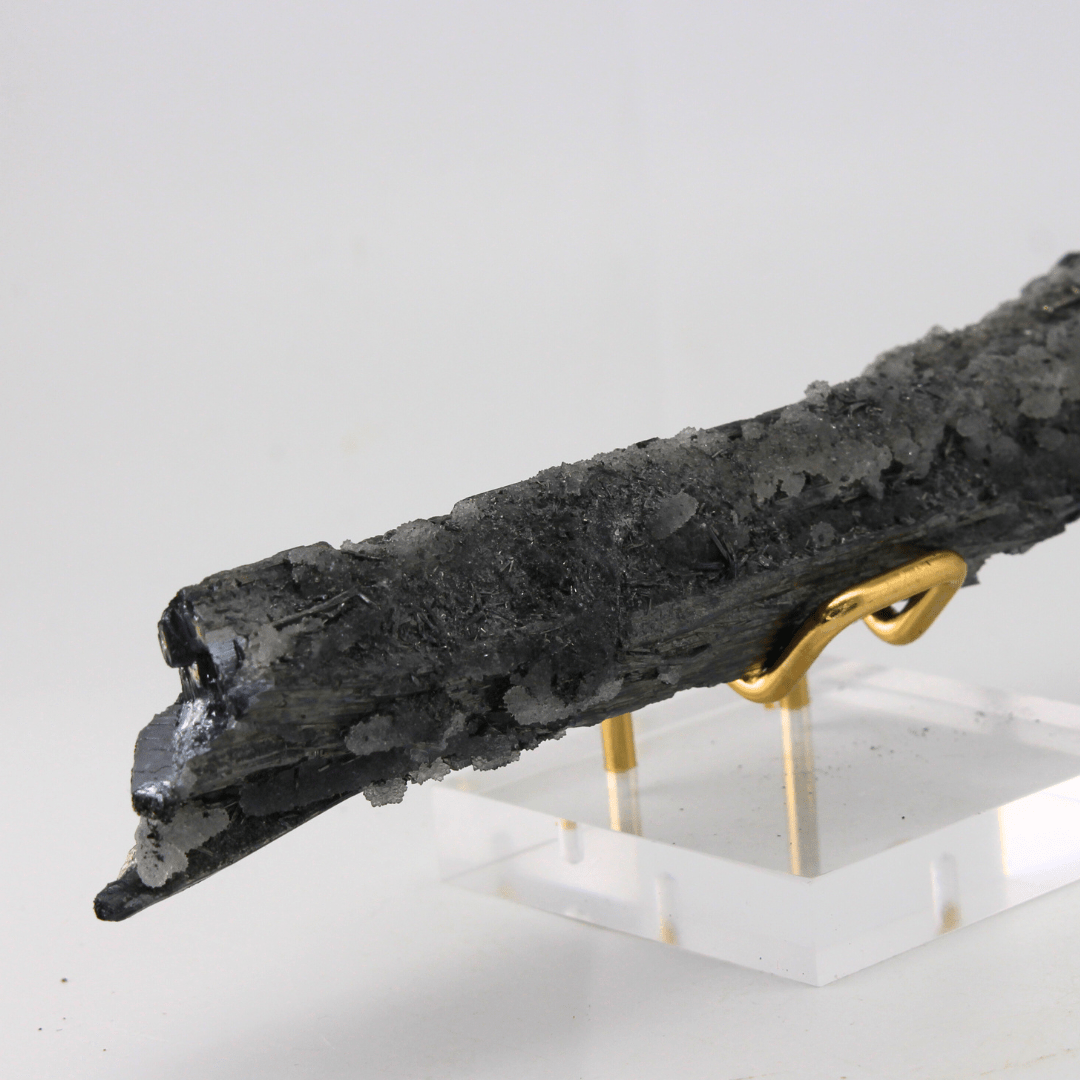SKU:S135g
Stibnite Naturally Terminated Asia 135g
Couldn't load pickup availability
Stibnite Naturally Terminated Asia 135g
Mineral Name: Stibnite Chemical Formula: Sb2S3 - Antimony Sulfide Color: Stibnite is known for its distinct metallic luster and silver-gray to lead-gray color. The mineral often has a steely or bluish iridescence on its surface. Crystal System: Orthorhombic Hardness: 2 on the Mohs scale Luster: Metallic Transparency: Opaque Specific Gravity: 4.63 - 4.68 Cleavage: Perfect in one direction Fracture: Uneven to subconchoidal Streak: Lead-gray Occurrences: Stibnite is commonly found in hydrothermal veins, often associated with antimony and other sulfide minerals. It occurs in various geological settings, including regions with antimony deposits. Notable occurrences include China, Bolivia, Romania, Mexico, and the United States. Notable Localities: Some famous stibnite localities include the Wuling Antimony Mine in China, the Măghernița mine in Romania, and the Ichinokawa mine in Japan. Formation: Stibnite forms in hydrothermal systems, where hot, mineral-rich fluids migrate through fractures in rocks. As these fluids cool, stibnite precipitates from solution, often crystallizing in elongated, needle-like structures. Unique Features: Stibnite is recognized for its characteristic appearance, consisting of long, slender crystals that often grow in radiating clusters. The crystals have a metallic luster and may exhibit a bluish iridescence on their surfaces. Stibnite's distinctive habit, combined with its association with antimony, makes it easily recognizable. Uses: Stibnite has been historically used as a significant source of antimony, a metalloid with various industrial applications. Antimony is utilized in the production of flame retardants, alloys, and certain types of batteries. While not commonly used as a gemstone, stibnite is valued for its unique appearance and is sought after by mineral collectors. Caution: Stibnite itself is not considered toxic, but antimony, a component of stibnite, can be toxic in certain forms. When handling stibnite specimens, it is advisable to wash hands thoroughly afterward and avoid inhalation of dust particles. Additionally, exposure to prolonged heat can cause stibnite to release antimony vapors, and care should be taken in such circumstances.Basic Info
| Condition Description | Stibnite Naturally Terminated Asia 135g - Black, Rough, No Stone - Luxury Watch - Not Enhance — curated by Imperial Time UK Ltd in London Kensington. Discover |
| Condition | New |
| Color | Black |
| Certification | Imperial Time UK Ltd |
| Case Size | 26mm |
| Short Description | Stibnite Naturally Terminated Asia 135g - Black, Rough, No Stone - Luxury Watch - Not Enhance — curated by Imperial Time UK Ltd in London Kensington. Discover |
| Year | 2024 |
| Width | 15mm |
| Vintage | No |
| Stone Colour Grade | D |
| Style | Loose Gemstones |
| Shape | Tube |
| Secondary Stone | No Stone |
| Occasion | Birthday |
| Main Stone Treatment | Not Enhanced |
| Main Stone Creation | Natural |
| Main Stone | No Stone |
| Gemstone Form | Rough |
| Main Stone Colour | Black |
| Seller Waranty | Yes |
| Number of Gemstones | 1.0 |
| Number of Diamonds | 0.0 |
| Material | Gemstone |
| Manufacturer | Imperial Time |
| Height | 26mm |








- Specifications
- Shipping And Return
Care Instructions: Regularly clean your jewellery to remove dirt, oils, and other residues that can dull its appearance. Use a soft, lint-free cloth to gently wipe the surface of the jewellery.
Customization Options: Allow customers to work with a jewellery designer to create custom pieces tailored to their specifications. This could include choosing specific gemstones, metals, settings, and design elements to create a one-of-a-kind piece.
Certifications and Authenticity: We provide certificates of authenticity and/or appraisal for our jewellery, depending on the item and its value. These certificates typically include information about the materials used, such as the type and quality of gemstones and metals, as well as details about the craftsmanship.
- Shipping costs are determined based on factors such as your location, the weight of your order, and the selected shipping method. You can view the shipping costs for your order during the checkout process.
- we offer international shipping to select countries. International orders may be subject to customs duties, taxes, and import fees, which are the responsibility of the customer.
- We want you to be completely satisfied with your purchase. If you are not satisfied for any reason, you may return your order within 30 days of delivery for a full refund or exchange.














